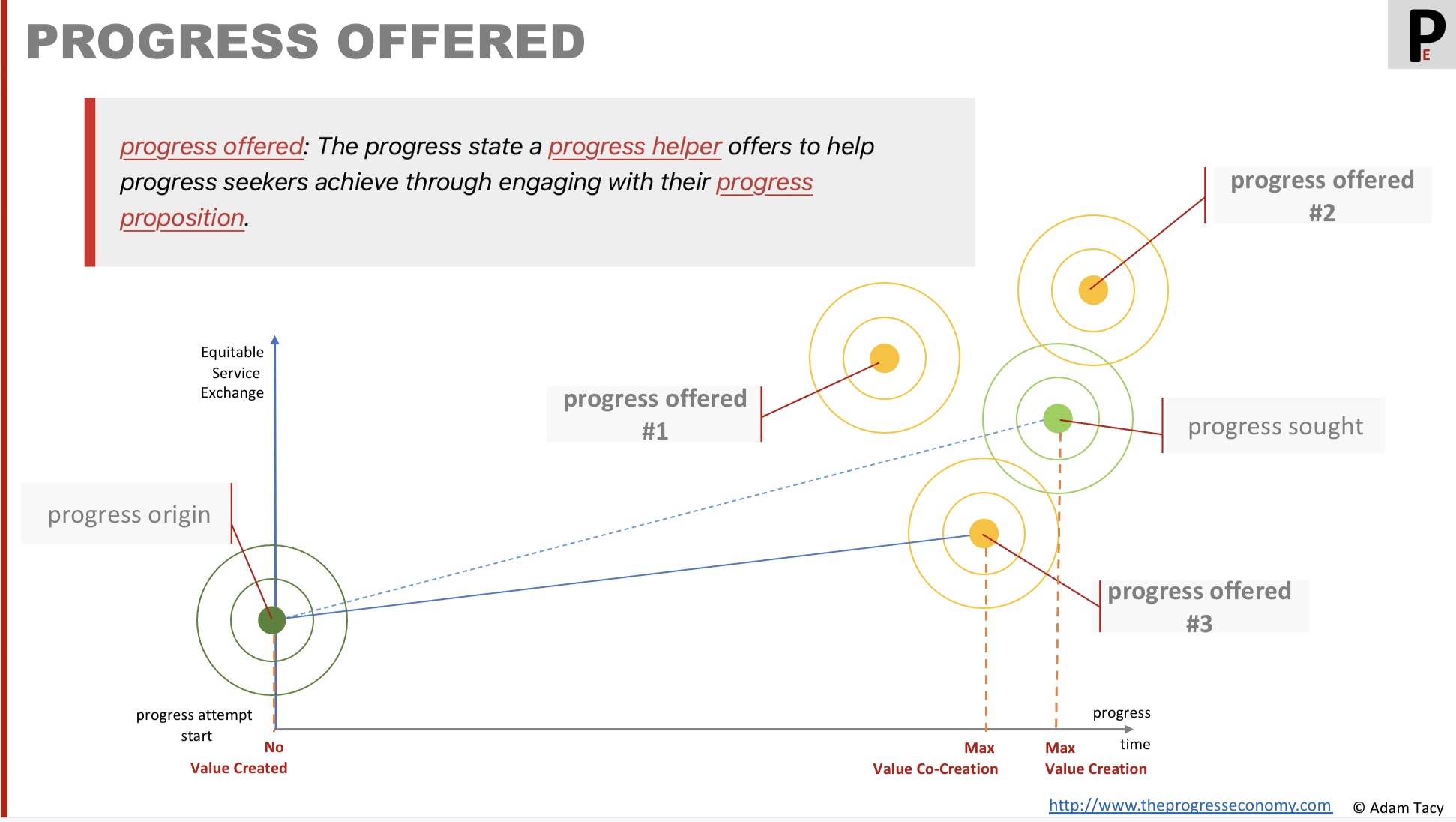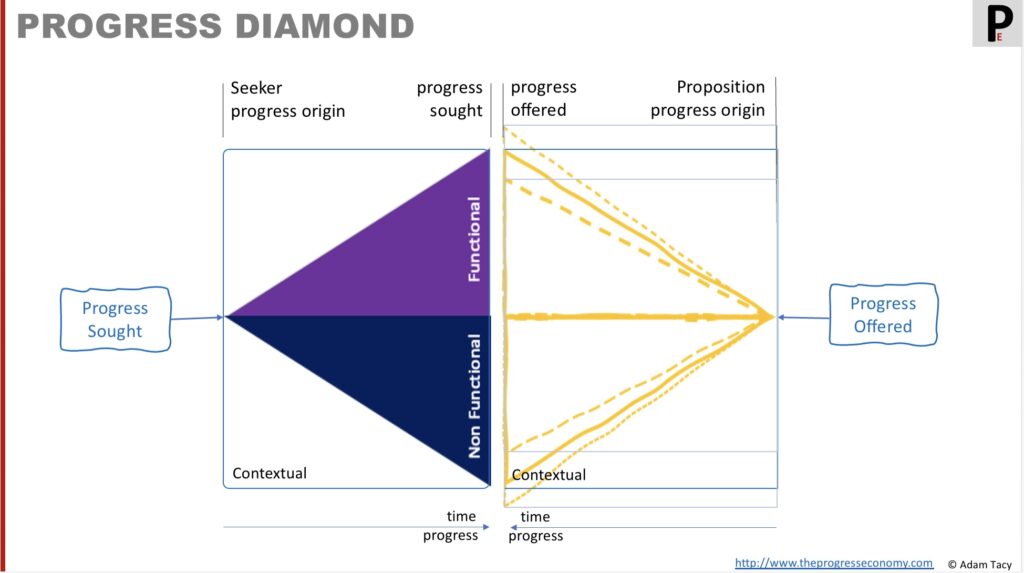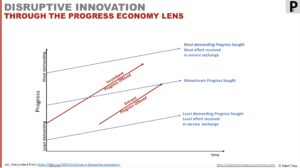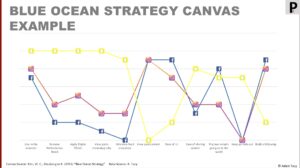What we’re thinking
Progress offered is the progress state a progress proposition offers to help a seeker reach.
Ideally, it should match each individual seeker’s progress sought. However, such customisation can significantly raise the equitable exchange progress hurdle. To address this challenge, helpers often segment seekers by progress sought, offering one or more generic progress offered. This streamlines their efforts, allowing the equitable exchange required to reduce.
Notably, some approaches to crafting progress offered encourage systematic deviations from the mainstream segment. Disruptive innovation and blue ocean strategy being two.
We observe that since progress offered likely differs from progress sought, then maximum value co-created differs from that obtainable from reaching progress sought. Innovation should, therefore, seek to reduce any gap between progress offered and individual seeker’s progress sought. In doing so, helpers must remain mindful of, and manage, what Christensen famously termed the “innovator’s dilemma”. Since surplus progress may not be realised by the seeker as extra value.
Furthermore, helpers are constantly pressured to innovate their progress offered, driven by the ever-evolving nature of progress sought.
Progress offered
Fundamentally, progress helpers aim to help progress seekers make progress by minimising the lack of resource progress hurdle seekers may encounter when making progress attempts. They do this by creating and offering progress propositions, which are packaged supplementary resources designed to:
- minimising any initial lack of resource progress hurdle encountered by a seeker
- enhancing a seeker’s perception of their own progress potential
- assisting the seeker in making progress
When crafting a proposition, a progress helper makes assumptions about the seeker’s progress origin, the resources the seeker lacks, and, the supplementary resources they can offer.
The helper judges the progress state that they feel can be achieved when using their proposition. Technically, this is a perspective on progress potential. However, in the progress economy we want to distinguish this to look at specifics, and so we will call this state by the better name of progress offered.
More formally, we define progress offered as:
progress offered: The progress state a progress helper offers to help progress seekers attempt to reach when engaging with the helper’s progress proposition.
It’s important to recognise that there is a necessary connection between progress offered and progress sought, a concept visualised in the progress diamond.
If progress offered is too far from progress sought there’s a high risk the seeker will not engage. However, as we will now explore, progress offered does not always have to directly align with progress sought.
Owning the progress offered
Finally we observe that progress helpers must actively manage their offerings by:
- understanding progress sought and craft appropriate propositions
- ensuring progress offered is executed properly
- addressesing the observation that progress sought by seekers is constantly evolving.
We propose a specific progress owner role. More enlightened helpers likely have a product owner role today. The progress owner role is a natural evolution to that.
Relating to progress sought
In an ideal world, progress offered would precisely match each individual seeker’s progress sought.
Think of this as the equivalent of ordering a bespoke tailored suit or dress. We get the material, buttons, button holes, stitching, pockets, and linings of our desires. The cut flatters our individual measurements. All tailored together with expert craftsmanship meaning it will last a lifetime.
However, several reasons may lead to differences:
Unable to make the progress sought (yet)
Some progress sought may currently be unattainable. It might be due to technological limitations or limitations from externalities. In the former cas, research and development efforts represent a form of service aimed at acquiring the necessary skills and knowledge.
Responding to progress sought injected by externalities
Externalities, such as governments, regulators, associations, or societal norms, inject elements into progress sought to minimise negative impacts (see here for why this is injected into progress sought).
Progress offered must align with any such progress sought injected – even when it contradicts seeker’s own progress sought.
For example, when seeking progress with downstream gas appliances, UK legislation requires the progress-making activities are performed by a certified and registered engineer. This is a resource likely lacking by a seeker and so ripe to be provided by a helper in a proposition. In which case the helper/helper’s employee must be that certified and registered engineer.
Segmenting to reduce progress hurdles
The extent of customisation required for aligning progress offered to progress sought can significantly raise progress hurdles. Resulting in a seeker deciding not to engaging. Particularly sensitive to this is the equitable exchange progress hurdle.
Helpers may choose to group seekers and develop a more generic offering for those groups. Doing so, they can streamline their efforts, reducing the equitable exchange required. At the risk that seekers near the ends of a group may find the progress offered less acceptable.
Let’s go back to the bespoke clothing example. A shift to off-the-peg clothing, with sizes such as small, medium, large, significantly reduces effort expended by the helper per seeker engagement. For a seeker, the clothing will not match them perfectly. But they are likely to find something acceptable. Which comes at a lower equitable exchange.
Segmenting seekers by progress sought (and potentially progress origin) is a powerful approach. Better than traditional approaches such as demographics. Approaches a helper might take are:
- Identifying a mainstream progress sought segment: This approach identifies a common progress sought that appeals to a large group of seekers.
- Identifying to a niche progress sought segment: Identifying a non mainstream segment of seekers that the helper will focus on.
- Appealing to multiple progress sought segments: Helpers segment seekers based on meaningful groupings of progress sought and offer various propositions, each catering to a specific segment.
- Customising segments: This approach identifies segments and offers some customisation to handle slight progress sought differences for each segment.
Deliberately deviating from offering mainstream progress sought
Interestingly, some helpers identify a mainstream progress sought segment and then look to systematically innovate to deviate away. This approach characterises disruptive innovation and blue ocean strategy.
And we may find more on our journey exploring the progress economy.
With disruptive innovation, new helpers spot the opportunity to apply a new technology to target seekers who have been overlooked or left behind by incumbent helpers (who are busy improving progress offered to chase more demanding customers who offer larger equitable exchange). They initially provide sufficient progress to meet the needs of these underserved seekers and then gradually enhance their progress offered – once they appeal to mainstream seekers, the market has been disrupted
Secondly, there is Blue Ocean Strategy. This involves identifying untapped and uncontested markets by strategically adjusting elements of progress offered away from mainstream (red oceans). Helpers carefully analyse mainstream progress sought and make deliberate choices to raise, lower, add, or remove certain elements to craft their unique and differentiated functional, non-functional and/or contextual progress offered.
Three powerful forces pressure progress offered to evolve
Three compelling forces drive helpers to evolve their progress offered.
Progress Sought constantly evolves
Seekers’ progress sought continually evolves. Seekers’ circumstances change and they are influenced by other progress attempts they make and observe, even in other industries and markets. Societal changes may also influence evolution of progress sought, such as increasing emphasis on sustainability, for example.
This means that what may have been considered significant progress offered today is seen as less tomorrow.
Advancements in Progress Activities
Continuous advancements in progress-making activities , driven by innovation in goods, processes, and business models, allow helpers to offer better progress, enhance existing progress, and lower progress hurdles.
Drive to maximise Equitable Service Exchange
And, finally, the purpose of a helper itself, drives them to evolve their progress offered.
the purpose of a progress helper is to attract maximum equitable service exchanges (number or size) with progress seekers – as such a progress helper has three, and only three, functions:
- marketing – continuous discovery of ever evolving progress sought
- executing – delivery of progress offered
- innovating – continuous innovation of progress offered towards progress sought
Their need to maximise equitable service exchanges pushes them to keep and attract more seekers. But there is a well known dilemma with chasing progress sought.
Beware The innovator’s dilemma
Progress helpers should be cautious when chasing evolving progress sought as they risk leaving mainstream customers behind. Christensen’s Innovator’s Dilemma illustrates this dynamic, where incumbents focusing on the evolving needs of demanding seekers may overlook less demanding customers. This can lead to disruptive innovations that attract underserved segments, ultimately disrupting incumbents.
We touched briefly on this above when looking at segmentation. There it was a positive to find growth for new entrants. Here it is a warning to incumbents: in the quest to chase higher equitable exchange helpers must navigate the dynamic of being disrupted carefully.
According to Christensen’s theory of disruptive innovation, once a new entrant successfully captures the mainstream segment, the incumbent helper is disrupted. And there’s usually no way back for them. RIP Blockbuster, Kodak, Nokia…
Relating to value
We know that maximum value emerges when a seeker reaches their progress sought. But now we have a fundamental question: what happens to value when progress offered differs from progress sought?

In essence, the maximum value generated when engaging with a proposition may not be the same as that created during a solo journey. The relationship between these two value scenarios depends on how progress offered aligns with progress sought.
- When Progress Offered is Less Than Progress Sought: In this case, the total value created during engagement with the proposition will be less than what a seeker might achieve independently. However, the seeker is likely engaging a proposition since they lack resource to progress alone. The seeker ultimately decides whether this reduced value is acceptable and sufficient trade-off for access to the supplementary resources offered.
- When Progress Offered is Greater Than Progress Sought: Surprisingly, having progress offered that exceeds progress sought doesn’t necessarily equate to additional value. If the seeker does not actively seek or require the extra progress, there’s no recognised value in it. Moreover, the surplus progress might inadvertently increase one or more progress hurdles, such as the equitable exchange.
There are also a couple of impacts on terminology we use.
Value co-creation
Progress is a joint endeavour when engaging a proposition. So now we say that any value that emerges is co-created.
value co-creation – The act, and result, of a progress seeker and a progress helper jointly making progress.
Value-in-use
Since value is now co-created, we recognise the way it emerges as a special case of value-through-progress that the literature calls value-in-use.
value-in-use – A view of value creation that sees value being increasingly co-created during a progress attempt as a progress seeker engages a progress proposition. Though it may not be realised until progress completes.
Helpers view of progress potential
Let’s loop back to our earlier comment saying progress offered is a reframing of a helper’s view of progress potential. This is why helpers like to make claims like “8 out of 10 dentists recommend our toothpaste for a better cleaning experience” or “Brand X washes 50m more plates than the leading competitor”. They are aiming to provide objective measures of progress potential with their proposition; an indication of future value.
Relating to innovation
Now we can tease out the framework of the progress economy’s definition of innovation. Simplistically, we need innovation to achieve two things:
- get progress offered to individual seeker’s progress sought
- reduce progress hurdles
Key recommendations
editing from here





Let’s progress together through discussion…